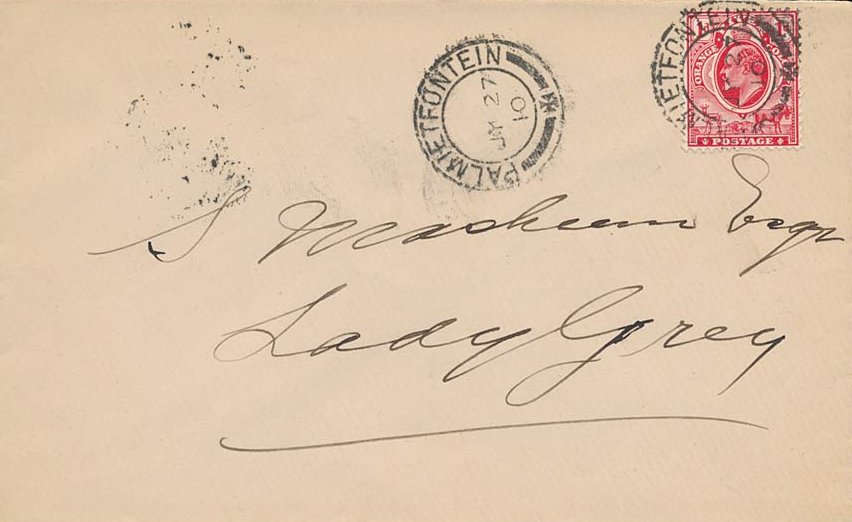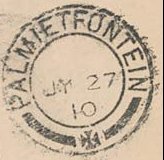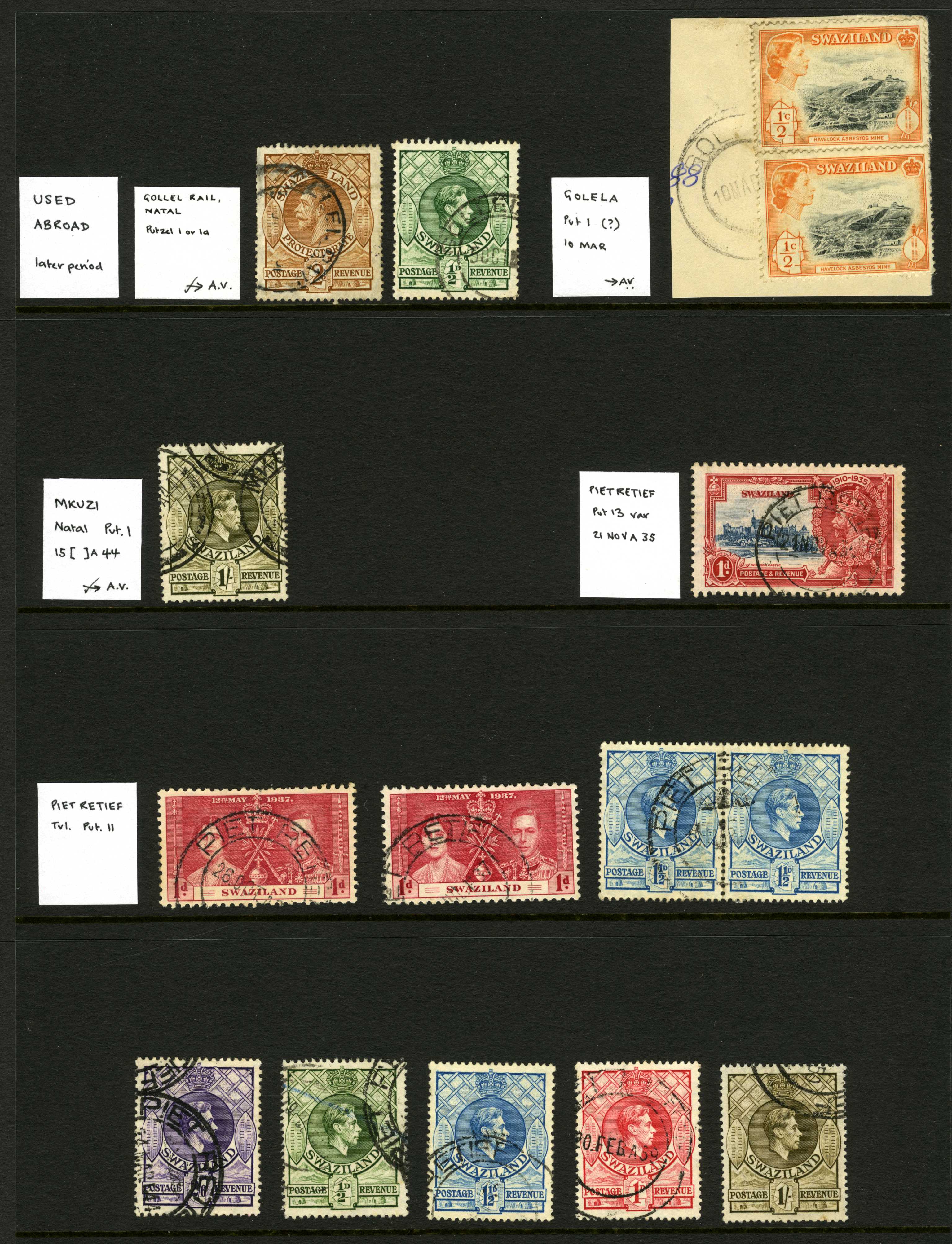Palmietfontein
Quote from Albertlr on February 20, 2021, 9:08 pmLetter, sent from Palmietfontein 27 JY 1910 to Lady Grey, arriving the next day JY 28 1910. Stamped with 1d Orange Free State King Edward VII issued 1903. Palmietfontein, post office open 1896, still today. Palmietfontein is located in the Cape at Sterkspruit. Is a border town near Lesotho. This letter, a fine example of a pre-interprovincial period. Is my explanation correct ? Does anyone have a map of the area?
Letter, sent from Palmietfontein 27 JY 1910 to Lady Grey, arriving the next day JY 28 1910. Stamped with 1d Orange Free State King Edward VII issued 1903. Palmietfontein, post office open 1896, still today. Palmietfontein is located in the Cape at Sterkspruit. Is a border town near Lesotho. This letter, a fine example of a pre-interprovincial period. Is my explanation correct ? Does anyone have a map of the area?
Uploaded files:Quote from Bas PAYNE on February 20, 2021, 9:43 pmPalmietfontein is in the NE Cape, very close to where the Cape, OFS and Lesotho meet. As the map shows, both borders are less than 10km from Palmietfontein, Lesotho to the NE and the OFS to the NW. Lady Grey, the destination of the card, is less than 25km from Palmietfontein, on the other side of Sterkspruit. It doesn't seem surprising that OFS stamps would have been accepted at that time in that area.
Palmietfontein is in the NE Cape, very close to where the Cape, OFS and Lesotho meet. As the map shows, both borders are less than 10km from Palmietfontein, Lesotho to the NE and the OFS to the NW. Lady Grey, the destination of the card, is less than 25km from Palmietfontein, on the other side of Sterkspruit. It doesn't seem surprising that OFS stamps would have been accepted at that time in that area.
Uploaded files:Quote from Steve on February 21, 2021, 11:21 amYour comment that "This letter, a fine example of a pre-interprovincial period", requres a small qualification. It is not "pre-interprovincial period" but "interprovincial period". Our understanding of this period has now changed.
With its date of 'JY 27 10', it is an early example of IP use. After a notice appeared in the Government Gazette on 19th August 1910, Colonial stamps were formally allowed to be used anywhere within the Union of South Africa. As a result, it was previously believed that the IP period ran from 19th August 1910 to the 31st August 1913 when the first 12 stamps of the King’s Head definitives issue bought the IP era to an end. However, as no covers have been found taxed between 1st June 1910 and 18th August 1912 for using colonial stamps outside of their province of origin, it appears that the IP period actually began earlier on 1st June 1910. Most South Africans were unaware that they were allowed to use the colonial stamps of other provinces during the period 1st June to 19th August when the notice appeared. As a result, they continued to use the colonial stamps of their province, making IP use between 1st June 1910 and 18th August less common than after 19th August 1910. For a long time, collectors, including me, have been confused by this. As it was allowed without penalty, it is now believed that the use of IP stamps was legal from 1st June 1910.
Your postmark is is an example of the old Cape Colony Pamlietfontein datestamp (date on more than one line as opposed to the Union's one line).
Your comment that "This letter, a fine example of a pre-interprovincial period", requres a small qualification. It is not "pre-interprovincial period" but "interprovincial period". Our understanding of this period has now changed.
With its date of 'JY 27 10', it is an early example of IP use. After a notice appeared in the Government Gazette on 19th August 1910, Colonial stamps were formally allowed to be used anywhere within the Union of South Africa. As a result, it was previously believed that the IP period ran from 19th August 1910 to the 31st August 1913 when the first 12 stamps of the King’s Head definitives issue bought the IP era to an end. However, as no covers have been found taxed between 1st June 1910 and 18th August 1912 for using colonial stamps outside of their province of origin, it appears that the IP period actually began earlier on 1st June 1910. Most South Africans were unaware that they were allowed to use the colonial stamps of other provinces during the period 1st June to 19th August when the notice appeared. As a result, they continued to use the colonial stamps of their province, making IP use between 1st June 1910 and 18th August less common than after 19th August 1910. For a long time, collectors, including me, have been confused by this. As it was allowed without penalty, it is now believed that the use of IP stamps was legal from 1st June 1910.
Your postmark is is an example of the old Cape Colony Pamlietfontein datestamp (date on more than one line as opposed to the Union's one line).
Quote from Bas PAYNE on February 21, 2021, 11:53 amIt's fairly clear also that there was a degree of tolerance in border areas - the attached page shows Swaziland stamps between the 1930's and the 1960's with postmarks of South African POs in border areas - places like Gollel, Mkuzi, and Piet Retief; I haven't yet seen a taxed cover.
It's fairly clear also that there was a degree of tolerance in border areas - the attached page shows Swaziland stamps between the 1930's and the 1960's with postmarks of South African POs in border areas - places like Gollel, Mkuzi, and Piet Retief; I haven't yet seen a taxed cover.
Uploaded files:



